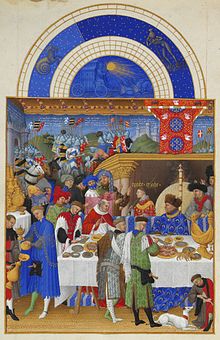"ජනවාරි" හි සංශෝධන අතර වෙනස්කම්
සුළු r2.7.1) (රොබෝ වෙනස් කරමින්: mdf:Кельмеков |
සුළු r2.6.5) (රොබෝ එකතු කරමින්: or:ଜାନୁଆରୀ |
||
| 193 පේළිය: | 193 පේළිය: | ||
[[nso:Pherekgong]] |
[[nso:Pherekgong]] |
||
[[oc:Genièr]] |
[[oc:Genièr]] |
||
[[or:ଜାନୁଆରୀ]] |
|||
[[os:Январь]] |
[[os:Январь]] |
||
[[pa:ਜਨਵਰੀ]] |
[[pa:ਜਨਵਰੀ]] |
||
20:09, 31 ජනවාරි 2012 තෙක් සංශෝධනය
ජනවාරි යනු ග්රෙගරි දින දසුන අනුව අවුරුද්දේ පළමු මාසයයි.
මෙම ලිපිය සත්යාපනය සඳහා (තවත්) මූලාශ්ර දැක්වීම කළ යුතුව ඇත. කරුණාකර මෙම ලිපිය විශ්වාස කළ හැකි මූලාශ්ර උපුටා දක්වමින් වැඩි දියුණු කිරීමට උදව් වන්න. මූලාශ්ර රහිත කරුණු අභියෝගයට ලක්වීමට හා මකා දැමීමට ඉඩ ඇත. (2008 ඔක්තෝබර්) |
| ග්රෙගරි වර්ෂ ක්රමයේ මාස: | ජනවාරි · | පෙබරවාරි · | මාර්තු · | අප්රේල් · | මැයි · | ජූනි · | ජූලි · | අගෝස්තු · | සැප්තැම්බර් · | ඔක්තෝබර් · | නොවැම්බර් · | දෙසැම්බර් |
| << | ජනවාරි | >> | ||||
|---|---|---|---|---|---|---|
| ඉරිදා | සඳුදා | අඟ. | බදාදා | බ්රහස් | සිකු. | සෙන. |
| 1 | 2 | 3 | 4 | 5 | 6 | |
| 7 | 8 | 9 | 10 | 11 | 12 | 13 |
| 14 | 15 | 16 | 17 | 18 | 19 | 20 |
| 21 | 22 | 23 | 24 | 25 | 26 | 27 |
| 28 | 29 | 30 | 31 | |||
| 2024 | ||||||
ජනවාරි ![]() (pronunciation) (උදවු·තොරතුරු) is the first month of the year in the Julian and ග්රෙගරි දින දසුනs, and one of seven Gregorian months with the length of 31 days. The first day of the month is known as New Year's Day. It is, on average, the coldest month of the year within most of the Northern Hemisphere and the warmest month of the year within most of the Southern Hemisphere.
(pronunciation) (උදවු·තොරතුරු) is the first month of the year in the Julian and ග්රෙගරි දින දසුනs, and one of seven Gregorian months with the length of 31 days. The first day of the month is known as New Year's Day. It is, on average, the coldest month of the year within most of the Northern Hemisphere and the warmest month of the year within most of the Southern Hemisphere.
History

January is named after Janus (Ianuarius), the god of the doorway; the name has its beginnings in Roman mythology, coming from the Latin word for door (ianua) - January is the door to the year. Traditionally, the original Roman calendar consisted of 10 months, totalling 304 days, winter being considered a monthless period. Around 713 BCE, the semi-mythical successor of Romulus, King Numa Pompilius, is supposed to have added the months of January and February, allowing the calendar to equal a standard lunar year (355 days). Although March was originally the first month in the old Roman Calendar, January became the first month of the calendar year either under Numa or under the Decemvirs about 450 BCE (Roman writers differ). In contrast, years in dates were identified by naming two consuls, who entered office on May 1 and March 15 before 153 BCE when they began to enter office on January 1.
Various Christian feast dates were used for the New Year in Europe during the Middle Ages, including March 25 and December 25. However, medieval calendars were still displayed in the Roman fashion of twelve columns from January to December. Beginning in the sixteenth century, European countries began officially making January 1 the start of the New Year once again — sometimes called Circumcision Style because this was the date of the Feast of the Circumcision, being the eighth day from December 25.
Historical names for January include its original Roman designation, Ianuarius, the Saxon term Wulf-monath (meaning wolf month) and Charlemagne's designation Wintarmanoth (winter / cold month).
ජනවාරියේ ඇති නිවාඩු දිනයන්

- New Year's Day – January 1
- Independence Day in Haiti - January 1
- Handsel Monday in Scotland and northern England – First Monday
- Three Wise Men Day in Latin America - January 6
- Russian and Ukrainian Christmas Eve, also known as Svyat Vechir - January 6
- Coptic Russian Orthodox Church Christmas – January 7
- Plough Sunday in Scotland and northern England – Sunday after January 6
- Coming of Age Day (成人の日, Seijin no hi) in Japan – Second Monday
- National Human Trafficking Awareness Day in the United States – January 11
- Martin Luther King, Jr. Day in the United States – Third Monday
- Australia Day in Australia – January 26
- Republic Day in India – January 26
- Makara Sankranthi (Festival of Harvest) in India – January 14
- Auckland Anniversary in Auckland, New Zealand – Monday closest to January 29
- Burns night in Scotland - January 25
- The uniting of Moldavia and Wallachia under the same ruler in 1859, Romania - January 24
January symbols


- January's birthstone is the garnet which represents constancy.
- Its birth flower is the Dianthus caryophyllus or Galanthus.[1]
- The Chinese floral emblem of January is the Prunus mume.[තහවුරු කර නොමැත]
- The Japanese floral emblem of January is the camellia.[තහවුරු කර නොමැත]
